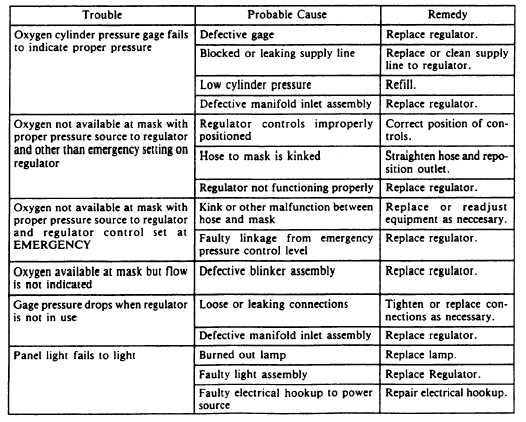the regulators preinstalled. Refer to table 12-4
for assistance in troubleshooting. To perform the
inspection, visually inspect the following:
1. Electrical performance of panel light.
2. Legibility of all markings.
3. Plastic lighting plate for cracks and
discoloration.
4. Low, or improper reading on regulator
pressure gauge.
5. Emergency pressure control lever in
NORMAL position.
6. Diluter control lever in 100-percent
OXYGEN position.
7. Supply control lever in OFF position.
8. Regulator and surrounding area for
freedom from dirt and hydrocarbons.
9. Delivery hose and connector for cuts,
graying, kinking, hydrocarbons and general
condition.
If discrepancies are found or suspected, notify
maintenance control.
If a regulator does not pass your inspection
and the defect cannot be repaired in the aircraft,
remove it and put in a ready for issue (RFI)
regulator. Forward the defective regulator to an
aircraft intermediate maintenance activity that can
fix it.
ACCEPTANCE/SPECIAL/DAILY
INSPECTIONS
The acceptance/special/daily inspections
consist of a visual inspection followed by
a functional test. These inspections and tests
are performed in conjunction with the air-
craft inspection requirements for the aircraft
in which the regulators are installed. These
inspections are performed at the organizational
level by AMEs. However, you should know
what they are supposed to inspect. Refer to
table 12-4 for assistance in troubleshooting.
To perform the inspection, visually inspect
the regulators as you did in the preflight
inspection.
Table 12-4.-Troublesbooting (Daily, Preflight, Special, Turnaround, Transfer and Acceptance Inspections)
12-8

